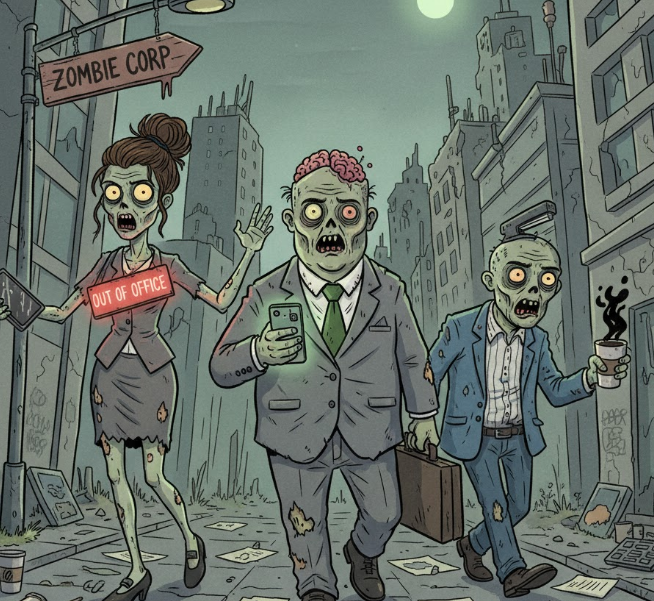
When Firms Can’t Die
Every few years, economies rise and fall—but some companies never really die. They shuffle along, unable to pay their debts, feeding on cheap credit instead of fresh profits. Economists have a name for them: zombie firms. And according to a sweeping study by the Bank for International Settlements (BIS), these undead businesses are multiplying worldwide.
The Walking Dead of the Business World
Zombie firms are companies that can’t cover their debt payments from profits for years at a time. They stay alive not because they’re innovative or competitive, but because they keep getting credit. In the 1980s, they made up only about 2% of listed firms in advanced economies. By 2016, that number had jumped to 12%
The BIS researchers—Ryan Banerjee and Boris Hofmann—studied over 32,000 firms across 14 countries, from the United States and Japan to France and Australia. Their findings show a disturbing trend: after every economic downturn, more zombies appear… and fewer ever go away.
But here’s the twist. These companies don’t just haunt investors—they drag down the entire economy.
How Did the Zombies Rise?
Economists first spotted zombie firms in Japan during its “Lost Decade” of the 1990s. Back then, weak banks refused to let struggling companies fail, afraid of admitting bad loans. Instead, they “evergreened” credit—rolling over debt to keep these firms alive. The BIS study confirms that this pattern went global after the 2008 financial crisis.
But the researchers also uncovered another, quieter culprit: low interest rates.
Since the 1980s, central banks have cut rates to fight recessions and stimulate growth. Yet those cheap rates also removed the natural pressure that forces weak firms to either recover or close. When borrowing is nearly free, even the unproductive can survive.
Banerjee and Hofmann found a clear link: lower nominal interest rates predicted higher shares of zombie firms. For every 10-percentage-point drop in rates since the mid-1980s, the share of zombies rose by about 17%.
In other words, money that was supposed to spark growth may also be quietly feeding the undead.
Why Zombies Matter (Even if You’re Not an Economist)
At first glance, zombie firms might sound like someone else’s problem. But their existence affects everyone—from factory workers in Italy to tech start-ups in India.
Here’s why: zombies hog resources that healthy companies need. They hold onto workers, factory space, and loans that could have gone to more productive businesses. The BIS study found that when the share of zombie firms in a sector increases by just 1%, investment by healthy firms falls by roughly 1% and employment growth drops by 0.3%.
It’s like running a race where some runners keep stumbling yet never leave the track. The rest have to slow down just to avoid tripping over them.
This “crowding-out effect” doesn’t just hurt individual firms—it drags down national productivity. Over time, economies with more zombies see slower growth, even as central banks pump in more money. The cure starts to resemble the disease.
Why Aren’t They Gone Yet?
If zombies are such a problem, why don’t they just die off? The answer lies in financial incentives.
For banks, admitting that a borrower has failed means taking a loss on their balance sheet. When interest rates are low, it’s easier to keep lending and hope things improve. For governments, letting companies fail can mean layoffs, lost votes, and bad headlines. And for investors, near-zero yields elsewhere make even a limping company seem worth the gamble.
The BIS paper highlights that the early 2000s marked a turning point: before then, unprofitable firms used to shrink debt faster than healthy ones. After 2000, that difference disappeared. Since then, zombies have been deleveraging more slowly, clinging to assets, and preventing the reallocation of capital that fuels growth.
The result? A slow, creeping drag on innovation—what some economists call “corporate congestion.”
The Global Fallout
This trend isn’t limited to Wall Street or Tokyo. In Europe, weak banks and slow restructuring laws have made it easy for zombies to linger. In the U.S., record-low interest rates after the Great Recession allowed even big-name firms to survive long after they should have restructured. And in emerging markets, similar patterns are now showing up as debt costs plunge.
The bigger danger, say the authors, is that zombification becomes self-reinforcing. When more firms stagnate, overall productivity falls, pushing growth and interest rates even lower. That, in turn, makes it even easier for new zombies to emerge—a kind of economic feedback loop that’s hard to break.
What Can Be Done?
The authors stop short of offering an easy fix, but their findings hint at a hard truth: monetary medicine always has side effects. Keeping interest rates low for too long might save jobs in the short run, but it also risks freezing economies into a half-alive state.
To break the cycle, policymakers may need to combine financial reform with smarter bankruptcy laws, stronger bank supervision, and targeted industrial policies that help reallocate resources from the dead to the living.
That’s easier said than done. As Bank of England economist Andrew Haldane put it, central banks face “a difficult trade-off.” Cut rates to help growth today, or raise them and risk a wave of failures tomorrow.
Let’s Explore Together
The story of zombie firms is more than financial horror—it’s a mirror for our economic choices. Should we keep rescuing the weak to protect jobs, or let markets clear and risk short-term pain? And how do we balance compassion for workers with discipline for companies?
What do you think?
- Could your country’s economy be quietly “zombifying”?
- What would happen if interest rates rose sharply tomorrow?
- And if you were a policymaker, would you pull the plug—or keep the life support on?



